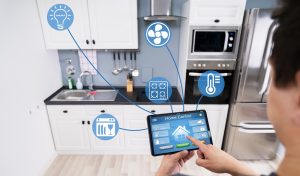
Electronic automation is transforming both smart homes and smart factories by creating interconnected, intelligent environments that prioritize efficiency, convenience, security, and sustainability. This is an industry hot spot for anyone seeking a position as an automation and electronic systems technician. Contact ITI Technical College to learn more about electronic automation in smart systems.
Electronic Automation In Smart Homes
 In the 1960s, a TV cartoon show called The Jetsons depicted a family living in an automated home with numerous advanced conveniences for its time. Many of them are available in today’s smart homes that provide these benefits:
In the 1960s, a TV cartoon show called The Jetsons depicted a family living in an automated home with numerous advanced conveniences for its time. Many of them are available in today’s smart homes that provide these benefits:
- Enhanced Convenience: electronic automation enables homeowners to remotely control various home functions or set automated schedules using a central hub, smartphone, or voice commands. This can include adjusting thermostats, controlling lights, locking doors, and checking security cameras.
- Improved Energy Efficiency: Smart homes utilize features like smart thermostats and lighting to optimize energy use based on occupancy and natural light. Energy monitoring systems also help identify areas for improvement.
- Enhanced Security: Automation improves security through the integration of smart cameras, video doorbells, and automated locks. IoT-enabled cameras offer real-time streaming, and motion detectors can trigger alerts.
- Seamless Interconnectivity: Smart devices can communicate to form a unified ecosystem, simplifying control and enhancing functionality. This can extend to interactions with other systems, like a car communicating with a home.
- Other Benefits: Homes can have automatic watering systems for live plants, robot vacuums, and auto shut-off for water fountains.
How Smart Home Automation Works
Smart home technology combines hardware, electronic interfaces, and communication interfaces that connect household devices to the Internet. Wired systems work best for new homes, while wireless systems are great for existing homes. Two concepts on which smart homes are based are automation and remote monitoring/access.
Automation is the capability to schedule events for devices connected to the network without human intervention. Programming the systems can turn lights on and off at specific times or switch on all lights if the security system triggers them.
These systems allow you to view and control them with an Internet-connected device. They offer information about your house, such as its current temperature, HVAC system malfunctions, and monitoring a security system. You can monitor your home automation systems remotely anytime you are away.
Electronic Automation In Smart Factories
It’s every factory manager’s dream to improve the quality, productivity, efficiency, and competitiveness of their operations. Electronic automation is a significant way to do this.
- Increased Production Efficiency and Agility: Electronic automation streamlines production by minimizing downtime and optimizing resource allocation. Automated systems monitor equipment and adjust operations to prevent bottlenecks.
- Improved Quality Control: Real-time monitoring systems help detect defects and inconsistencies, allowing for immediate corrective actions.
- Enhanced Worker Safety: Automation reduces the need for manual handling of hazardous tasks, minimizing the risk of accidents and injuries. Automated systems can perform tasks, such as handling high-temperature materials and hazardous chemicals.
- Sustainability and Energy Management: Automation contributes to green manufacturing by enabling precise control over energy consumption and reducing waste. This includes optimizing machine schedules and integrating renewable energy.
- Addressing Labor Shortages: Automation can help address labor shortages by taking over repetitive tasks, allowing employees to focus on higher-value activities.
- Cost Reduction: Automation can reduce labor costs, material waste, and energy consumption, leading to significant savings.
- Flexibility and Adaptability: Smart factories can easily adapt to changing production needs and product variations, enabling flexible manufacturing.
|
“Electronic automation is transforming both smart homes and smart factories by creating interconnected, intelligent environments that prioritize efficiency, convenience, security, and sustainability.” |
How Smart Factory Automation Works
 Electronic automation in smart factories leverages interconnected systems and digital technologies to improve overall operations. It involves using sensors, programmable logic controllers (PLCs), and other automation devices to monitor, control, and optimize various processes.
Electronic automation in smart factories leverages interconnected systems and digital technologies to improve overall operations. It involves using sensors, programmable logic controllers (PLCs), and other automation devices to monitor, control, and optimize various processes.
A network of sensors for temperature, pressure, flow, position, and more is deployed throughout the factory to collect real-time data on various parameters of manufacturing processes and equipment. The data is transmitted to control systems, such as PLCs or cloud-based platforms, for analysis and processing.
PLCs act as the brain of the automated system, receiving data from sensors and executing pre-programmed instructions to control various devices and processes. They can adjust motor speeds, line rates, and energy usage based on real-time data, optimizing resource allocation and minimizing waste. By analyzing sensor data, PLCs can predict potential equipment failures and schedule maintenance proactively, minimizing downtime.
IoT devices and sensors connect machines, systems, and processes, enabling seamless communication and data exchange. Artificial intelligence algorithms analyze the data collected to identify patterns, optimize performance, and automate decision-making processes. Cloud platforms provide the infrastructure for storing, processing, and analyzing large volumes of data generated by a smart factory.
The Future Of Electronic Automation
The future of electronic automation in smart systems involves advancements in AI, IoT, 5G, and edge computing. These innovations are expected to lead to greater intelligence, customization, and energy efficiency. Prepare for a career with the Automation & Electronic Systems Technology (AOS) Associate In Occupational Studies Degree at ITI Technical College in our professional training program. Your future starts now.
For more information about graduation rates, the median debt of students who completed the program, and other important information, please visit our website: https://iticollege.edu/disclosures/




